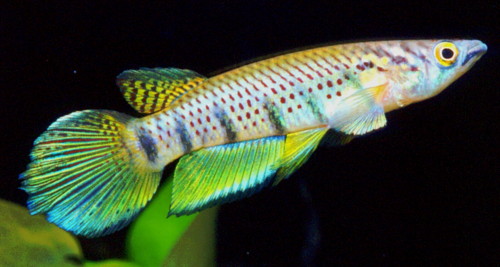Epiplatys togolensis Loiselle 1971

E.togolensis Benin. Photo courtesy of Ed Pürzl.
| Meaning of Name |
After the country of origin - Togo. |
||||||
| First Description |
Loiselle P.V. 1971. (Epiplatys sexfasciatus togolensis). The biology of Epiplatys sexfasciatus Gill 1862 (Teleostomi: Cyprinodontidae: Rivulinae) in southeastern Dahomey & the Togo Hills. Journal of the American Killifish Association (JAKA) 7 (2): p 29-53, figures, map. |
||||||
| Size |
61 mm (Standard Length, as given in the original description). |
||||||
| Meristics |
|
||||||
| Karyotype |
n = 24, A = 25 (Scheel 1974, 1990) |
||||||
| Sub-Genus |
Epiplatys |
||||||
| Group |
sexfasciatus |
||||||
| Synonyms |
|
||||||
Populations
|
Cotonou - Probable first collection in the 1980's. These were distributed in Germany from Vienna, probably collected by Ed Pürzl. Djigbé - Collected by Armbruster
in the 1980's. Igolo - Collected by Armbruster in the 1980's. RT 11 - Etzel & Putz collected this location in the 1980's from Togo & distributed in Germany. Reported as being very similar to the Cotonou population brought back by Pürzl. RT 18 - Thought to be extenct in the hobby by 2009. Photo in DKG Newsletter 42 (5). E.aff.togolensis IWO - NTC 07 / 1 - Seen on Aquabid April 2009.
Loiselle 1971 - This
one was probably called E.sexfasciatus
togolensis & described as such by Loiselle in 1971.
Now regarded as a synonym. |
||||||
| Type Locality |
Given as the 'Headwaters of the Hedjo (Todzie) River in the coffee plantation of the chief of Eyo, a small village 8 km north of the town of Palimé in the Republic of Togo'. |
||||||
| Distribution |
Coastal rainforest from Togo through the Niger Delta to the Cross River in southeastern Nigeria. http://homepage.uibk.ac.at/homepage/c102/c102mr/epiplaty/togolens.htm |
||||||
| Habitat |
Small rivers & brooks. Also quieter parts of larger rivers. |
||||||
| Distinguishing Characteristics | |||||||
| Colour/Pattern Variability | High | ||||||
| History |
Loiselle, P.V. 1971. The Biology of Epiplatys sexfasciatus Gill, 1862 (Teleostomi, Cyprinodontidae, Rivulinae) in Southeastern Dahomey and the Togo Hills. J. Amer. Killifish Assoc., 7 (2): 37, fig. 2. - This is the reference to the original description. Jan Pap collected this sp. in the early 1980's
in Gabon. A population from Cotonou circulated in Germany in the 1980's.
Pürzl collected them from Somakak. |
||||||
| Breeding Notes |
Most populations are easy to breed. It has been reported that some are more difficult but no details were given. This is a typical top spawner laying in floating mops. I incubated eggs in a seperate container. Water incubation takes around 14 days. I have put eggs on wet peat & hatched one month later without problem. The Lagos population commonly seen can be prolific. Growth is quite fast with sexual maturity being attained around 5-6 months. The wild fish I had in 2004 were put one pair
to each tank. Eggs appeared on mops which were taken out but lots of
fry could be seen with the parents which seemed to go unmolested. Fry
were easily raised on brine shrimp.
|
||||||
| Diameter of Egg | |||||||
| Remarks |
|






